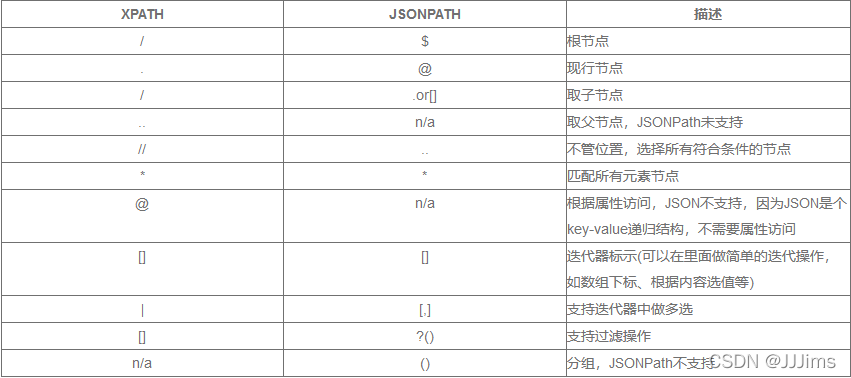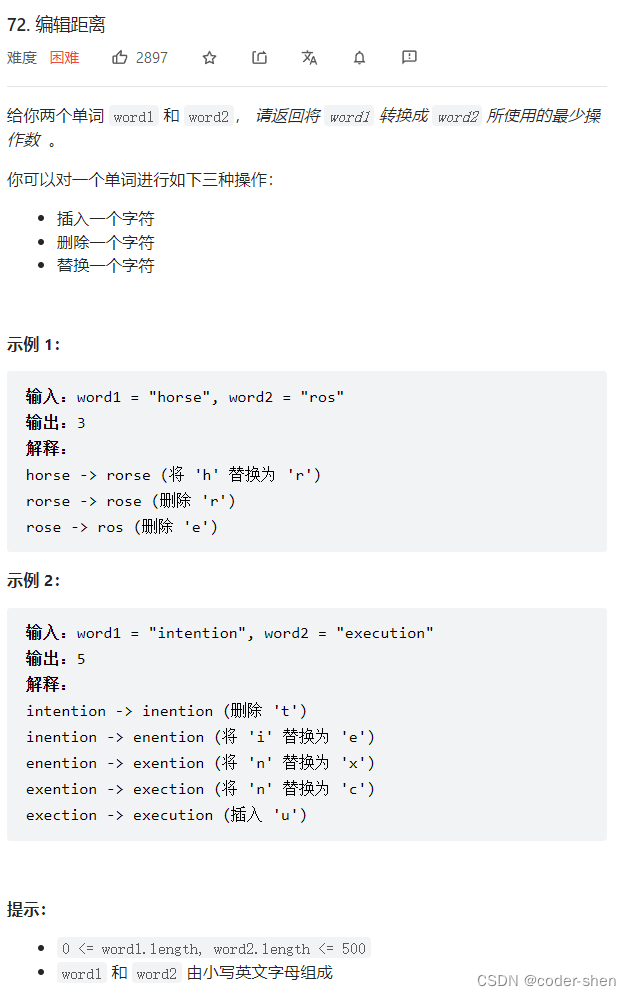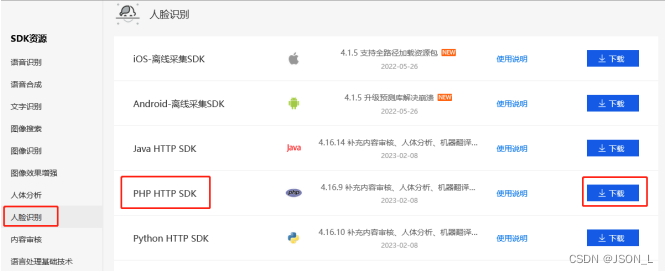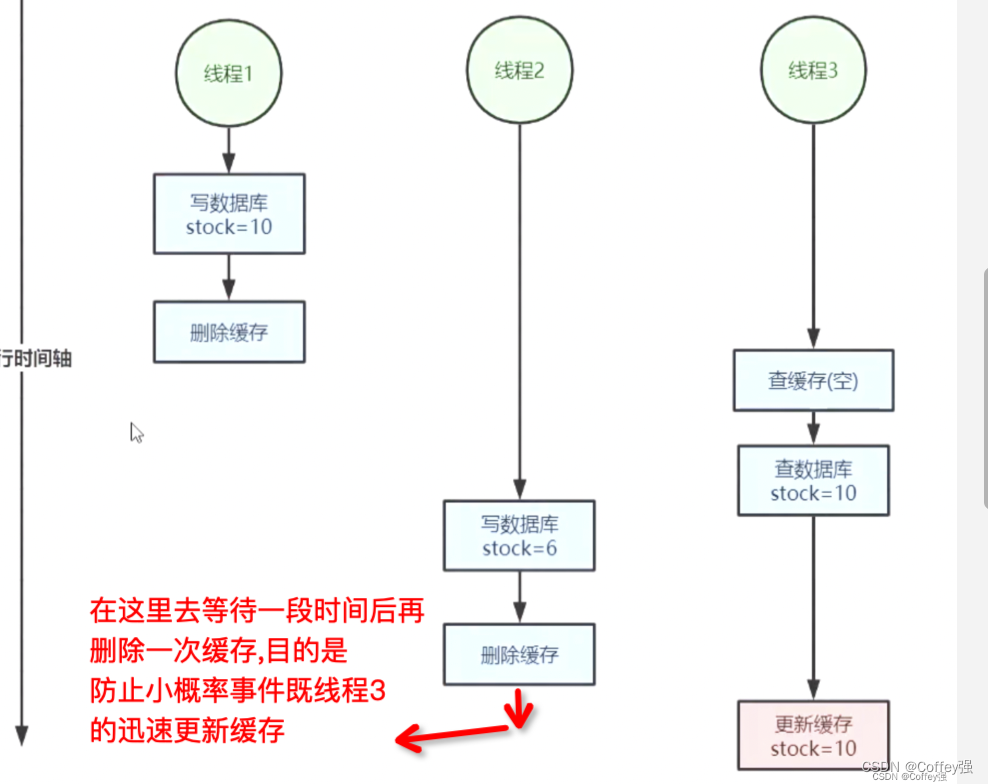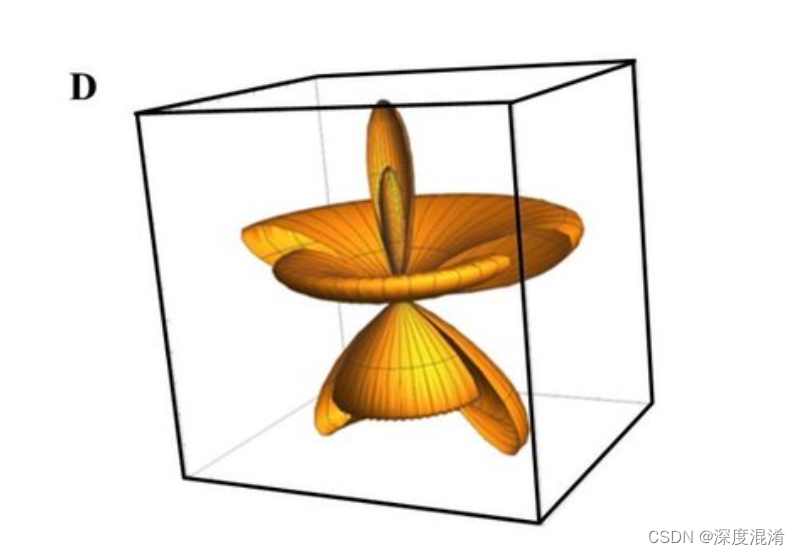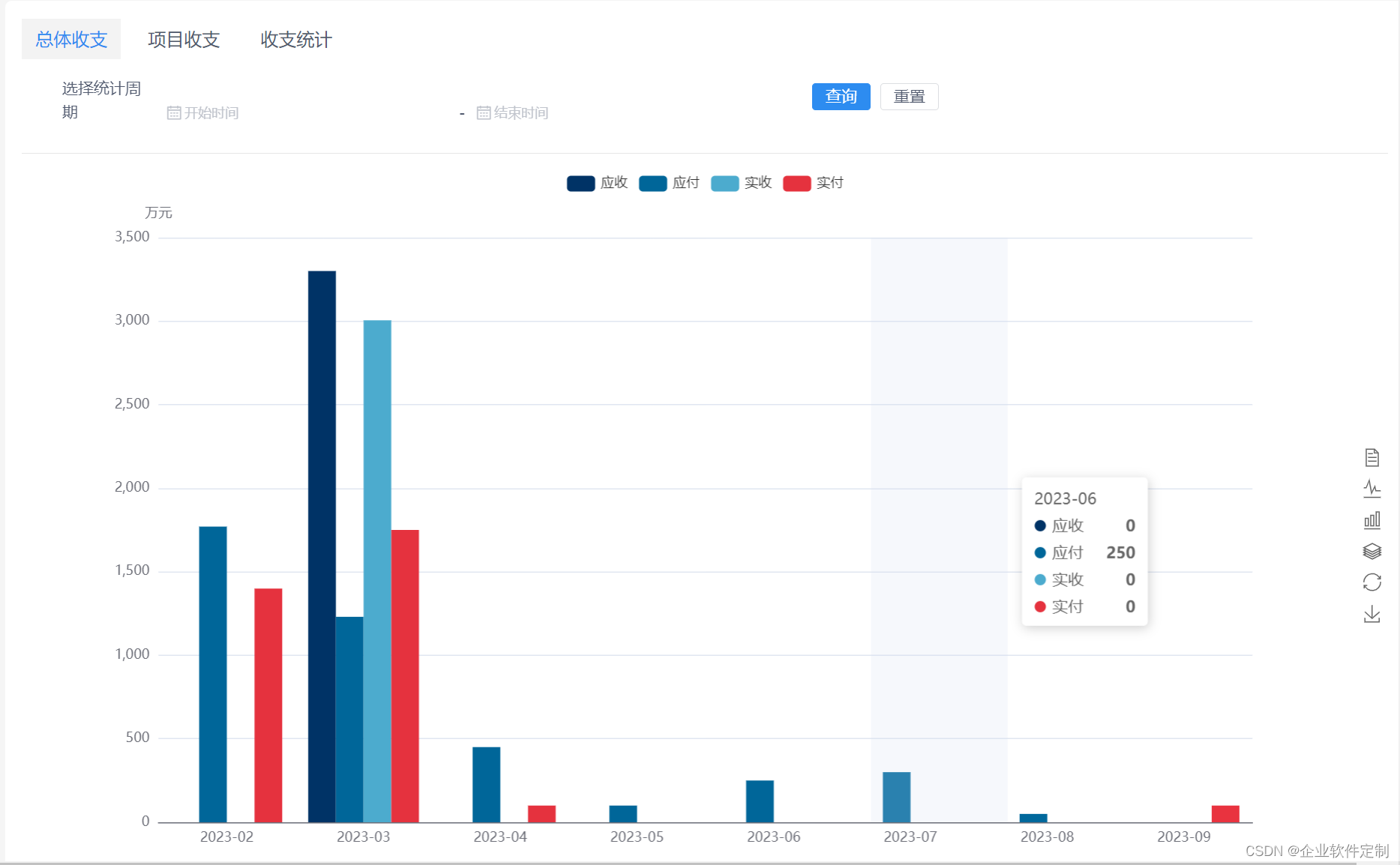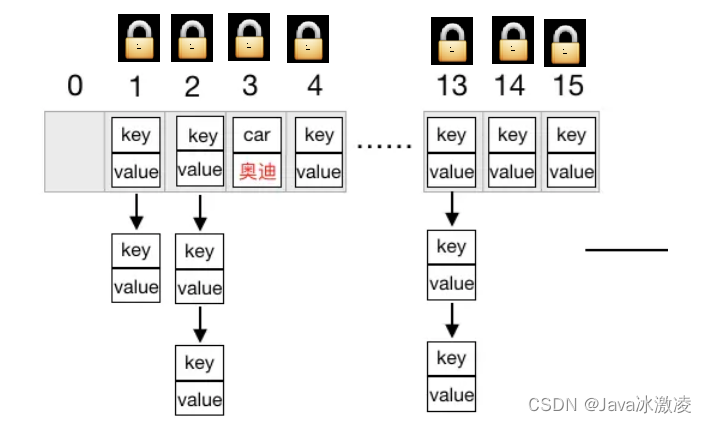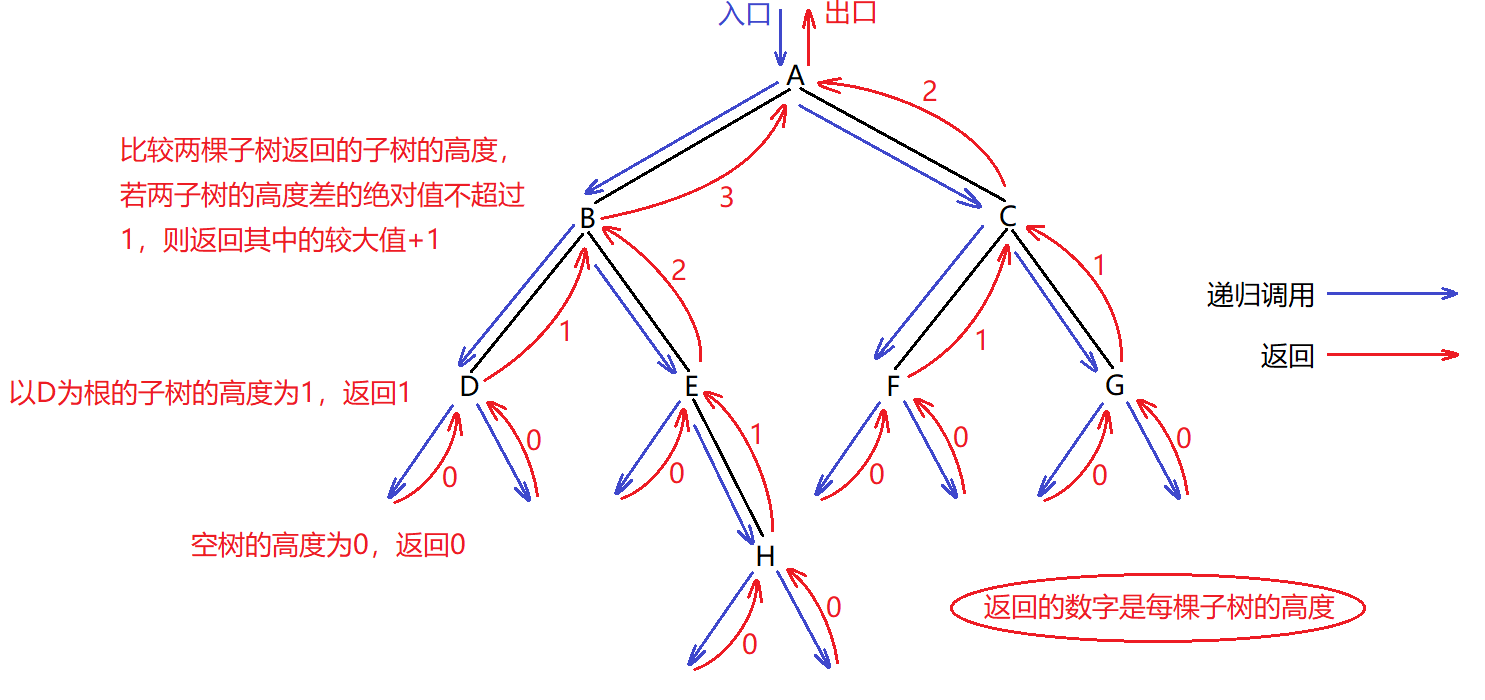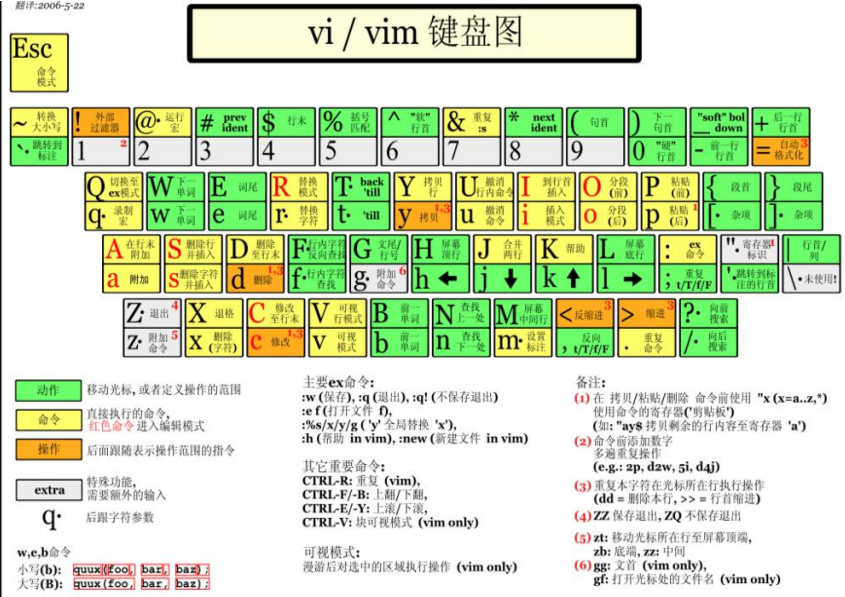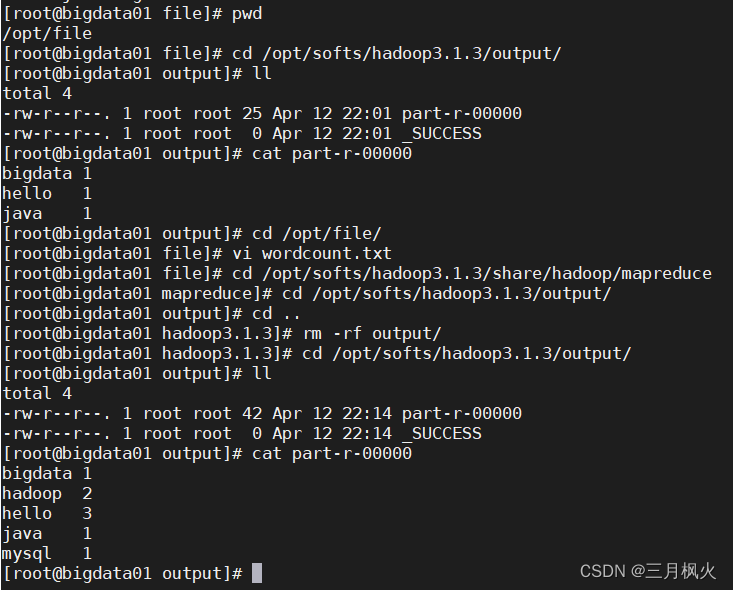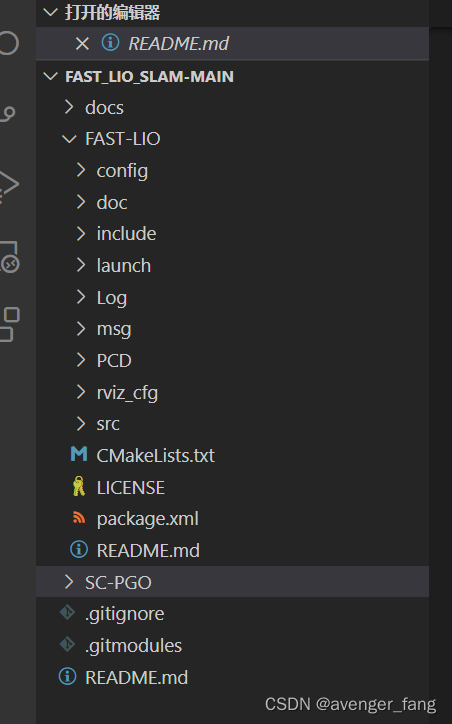
代码结构很清晰,从最外层看包含两个文件夹,一个是fast-lio,另外一个是加上scan-context的回环检测与位姿图优化。
fast-lio
主要是论文的fast-lio2论文的实现,包括前向处理和ikd-tree的实现

1.先从cmakelist入手看代码结构:
#这是定义代码中的ROOT_DIR
add_definitions(-DROOT_DIR=\"${CMAKE_CURRENT_SOURCE_DIR}/\")
#寻找机器的cpu核数,来选择是否采用多核计算,且留一个核的余量
if(CMAKE_SYSTEM_PROCESSOR MATCHES "(x86)|(X86)|(amd64)|(AMD64)" )
include(ProcessorCount)
ProcessorCount(N)
message("Processer number: ${N}")
if(N GREATER 4)
add_definitions(-DMP_EN)
add_definitions(-DMP_PROC_NUM=3)
message("core for MP: 3")
elseif(N GREATER 3)
add_definitions(-DMP_EN)
add_definitions(-DMP_PROC_NUM=2)
message("core for MP: 2")
else()
add_definitions(-DMP_PROC_NUM=1)
endif()
else()
add_definitions(-DMP_PROC_NUM=1)
endif()
#依赖openMP PythonLibs MATPLOTLIB_CPP_INCLUDE_DIRS绘图库
#自定义了 Pose6D.msg
add_message_files(
FILES
Pose6D.msg
)
#主要程序是
src/laserMapping.cpp
include/ikd-Tree/ikd_Tree.cpp
src/preprocess.cppPose6D.msg:
雷达在IMU坐标系下的预积分值
float64 IMU 和 第一帧雷达点的时延
float64[3] acc # the preintegrated total acceleration (global frame) at the Lidar origin
float64[3] gyr # the unbiased angular velocity (body frame) at the Lidar origin
float64[3] vel # the preintegrated velocity (global frame) at the Lidar origin
float64[3] pos # the preintegrated position (global frame) at the Lidar origin
float64[9] rot # the preintegrated rotation (global frame) at the Lidar origin
主程序入口在src/laserMapping.cpp 中,其他的两个cpp以库的形式给它使用
main()程序流程:
ros节点初始化-》参数读取--》参数初始化、指针初始化---》读取的雷达和IMU外参矩阵---》IMU积分参数设置,如测量协方差 ----》设置卡尔曼滤波器的参数,如迭代精度设置、迭代次数,迭代卡尔曼滤波器模型等-----》日志记录初始化
1. 获取激光雷达类型之后,开始订阅standard_pcl_cbk() 、 imu_cbk()
time_buffer为基于激光时间戳的队列,安装激光时间进行处理
void standard_pcl_cbk(const sensor_msgs::PointCloud2::ConstPtr &msg) //velodyne回调
{
mtx_buffer.lock();
scan_count ++;
double preprocess_start_time = omp_get_wtime();//可以理解为当前时间戳
if (msg->header.stamp.toSec() < last_timestamp_lidar) //检测激光时间戳是否异常
{
ROS_ERROR("lidar loop back, clear buffer");
lidar_buffer.clear();
}
PointCloudXYZI::Ptr ptr(new PointCloudXYZI());
p_pre->process(msg, ptr); //激光雷达预处理,获得特征点云
lidar_buffer.push_back(ptr); //激光雷达预处理完的雷达数据
time_buffer.push_back(msg->header.stamp.toSec()); //time_buffer是以激光雷达时间戳为基准的时间戳队列
last_timestamp_lidar = msg->header.stamp.toSec();
s_plot11[scan_count] = omp_get_wtime() - preprocess_start_time; //用于绘图显示处理时间
mtx_buffer.unlock();
sig_buffer.notify_all(); //信号量的提示 唤醒线程
}
void imu_cbk(const sensor_msgs::Imu::ConstPtr &msg_in)
{
publish_count ++;
// cout<<"IMU got at: "<<msg_in->header.stamp.toSec()<<endl;
sensor_msgs::Imu::Ptr msg(new sensor_msgs::Imu(*msg_in));
if (abs(timediff_lidar_wrt_imu) > 0.1 && time_sync_en) //timediff_lidar_wrt_imu仅在使用lovix雷达时才会使用
{
msg->header.stamp = \
ros::Time().fromSec(timediff_lidar_wrt_imu + msg_in->header.stamp.toSec());
}
double timestamp = msg->header.stamp.toSec(); //经过补偿的IMU时间戳,如果是lovix雷达才需要补偿,其他不需要
mtx_buffer.lock();
if (timestamp < last_timestamp_imu) //校验IMU时间戳的一维性,检测跳变
{
ROS_WARN("imu loop back, clear buffer");
imu_buffer.clear();
}
last_timestamp_imu = timestamp; //最新IMU的时间
imu_buffer.push_back(msg); //数据插入队列中
mtx_buffer.unlock();
sig_buffer.notify_all(); //有信号时,唤醒线程
}此次的激光点云回调会调用预处理类,获得特征点云的输出。
然后开启ros的无限循环,当然,此处添加了信号处理,通常终端结束进程时是通过发送信号的,当收到信号时,唤醒所以线程。
2.这里需要先看测量量的定义:
包括了当前帧点云和imu数据队列
struct MeasureGroup // Lidar data and imu dates for the curent process
{
MeasureGroup()
{
lidar_beg_time = 0.0;
this->lidar.reset(new PointCloudXYZI());
};
double lidar_beg_time;
PointCloudXYZI::Ptr lidar;
deque<sensor_msgs::Imu::ConstPtr> imu;
};3.然后看数据同步:bool sync_packages(MeasureGroup &meas)
//这部分主要处理了buffer中的数据,将两帧激光雷达点云数据时间内的IMU数据从缓存队列中取出,进行时间对齐,并保存到meas中
bool sync_packages(MeasureGroup &meas)
{
if (lidar_buffer.empty() || imu_buffer.empty()) {
return false;
}
/*** push a lidar scan ***/
if(!lidar_pushed) //如果程序初始化时没指定,默认值是false, 是否已经将测量值插入雷达帧数据
{
meas.lidar = lidar_buffer.front(); //将雷达队列最前面的数据塞入测量值
if(meas.lidar->points.size() <= 1) //保证塞入的雷达数据点都是有效的
{
lidar_buffer.pop_front();
return false;
}
meas.lidar_beg_time = time_buffer.front(); //雷达的时间按照time_buffer队首处理,因为它存的就是雷达的时间戳
//雷达帧头的时间戳是帧头的时间戳,这和驱动有关系,通过公式推导该帧激光的帧尾时间戳
lidar_end_time = meas.lidar_beg_time + meas.lidar->points.back().curvature / double(1000);
lidar_pushed = true; // 成功提取到lidar测量的标志
}
if (last_timestamp_imu < lidar_end_time) //如果最新的IMU时间戳都闭雷达帧尾的时间早,则这一帧不处理了
{
return false;
}
/*** push imu data, and pop from imu buffer ***/
double imu_time = imu_buffer.front()->header.stamp.toSec(); //从最早的IMU队列开始,初始化imu_time
meas.imu.clear();
while ((!imu_buffer.empty()) && (imu_time < lidar_end_time))
{
imu_time = imu_buffer.front()->header.stamp.toSec(); //从最早的IMU队列开始
if(imu_time > lidar_end_time) break; //没有跳出循环的话就会将IMU数据添加进去测量量
meas.imu.push_back(imu_buffer.front());
imu_buffer.pop_front(); //弹出已经塞进测量量的IMU数据
}
//从这出来的,测量数据中包含了当前帧的激光数据, 当前帧帧尾结束前的新增IMU数据
lidar_buffer.pop_front(); //处理过的数据出栈
time_buffer.pop_front();
lidar_pushed = false; //又重新置位,这样下一帧雷达来了又可以刷新时间,获取点云帧头和帧尾的时间
return true;
}
这个同步是基于激光雷达的数据存入测量量,获得帧头和帧尾之间的IMU数据队列,存入测量量中。
4.上面用到了激光的预处理,这里先插播激光预处理的内容:
通过实例 shared_ptr<Preprocess> p_pre(new Preprocess());进行预处理,预处理仅在激光回调中使用,激光回调前是读取参数设置预处理的参数。
preprocess.h/cpp
#define IS_VALID(a) ((abs(a)>1e8) ? true : false) //定义一个数字是否有效
//使用枚举变量描述激光的几个特征,
enum LID_TYPE{AVIA = 1, VELO16, OUST64}; //{1, 2, 3}
enum Feature{Nor, Poss_Plane, Real_Plane, Edge_Jump, Edge_Plane, Wire, ZeroPoint};
enum Surround{Prev, Next};
enum E_jump{Nr_nor, Nr_zero, Nr_180, Nr_inf, Nr_blind};
void Preprocess::set(bool feat_en, int lid_type, double bld, int pfilt_num)
{
feature_enabled = feat_en;
lidar_type = lid_type;
blind = bld;
point_filter_num = pfilt_num; //设置雷达盲区和类型
}
//针对机械雷达
void Preprocess::process(const sensor_msgs::PointCloud2::ConstPtr &msg, PointCloudXYZI::Ptr &pcl_out)
{
switch (lidar_type)
{
case OUST64:
oust64_handler(msg);
break;
case VELO16:
velodyne_handler(msg);
break;
default:
printf("Error LiDAR Type");
break;
}
*pcl_out = pl_surf;//输出分割后的面点
}
//将点云格式转化为ROS消息类型,但是没有发布
void Preprocess::pub_func(PointCloudXYZI &pl, const ros::Time &ct)
{
pl.height = 1; pl.width = pl.size();
sensor_msgs::PointCloud2 output;
pcl::toROSMsg(pl, output);
output.header.frame_id = "livox";
output.header.stamp = ct;
}
void Preprocess::velodyne_handler(const sensor_msgs::PointCloud2::ConstPtr &msg)
{
pl_surf.clear();
pl_corn.clear();
pl_full.clear(); //清空面点、角点点云
pcl::PointCloud<velodyne_ros::Point> pl_orig;
pcl::fromROSMsg(*msg, pl_orig);
int plsize = pl_orig.points.size();
pl_surf.reserve(plsize);//原始点云大小
bool is_first[MAX_LINE_NUM];
double yaw_fp[MAX_LINE_NUM]={0}; // yaw of first scan point
double omega_l=3.61; // scan angular velocity //10Hz 0.1s转360度
float yaw_last[MAX_LINE_NUM]={0.0}; // yaw of last scan point
float time_last[MAX_LINE_NUM]={0.0}; // last offset time
if (pl_orig.points[plsize - 1].time > 0) //假如提供了每个点的时间戳
{
given_offset_time = true; //提供时间偏移
}
else
{
given_offset_time = false;
memset(is_first, true, sizeof(is_first)); //初始化数组
double yaw_first = atan2(pl_orig.points[0].y, pl_orig.points[0].x) * 57.29578; //180/PI = 57.29
double yaw_end = yaw_first; //该帧第一个点的yaw角
int layer_first = pl_orig.points[0].ring; //该帧第一个点的所在环
for (uint i = plsize - 1; i > 0; i--)
{
if (pl_orig.points[i].ring == layer_first)
{
yaw_end = atan2(pl_orig.points[i].y, pl_orig.points[i].x) * 57.29578; //在同一个线上的点的yaw角
break;
}
} //所以这里的yaw_end角是指和第一个点的同线序的点圆环的角度
}
if(feature_enabled) //使用特征,这个参数打开
{
for (int i = 0; i < N_SCANS; i++)
{
pl_buff[i].clear();
pl_buff[i].reserve(plsize);
}
for (int i = 0; i < plsize; i++)
{
PointType added_pt;
added_pt.normal_x = 0; //法线
added_pt.normal_y = 0;
added_pt.normal_z = 0;
int layer = pl_orig.points[i].ring;
if (layer >= N_SCANS) continue; //这里过滤掉设置的线束N_SCANS,如果真实的雷达和N_SCANS不一致,用的是N_SCANS
added_pt.x = pl_orig.points[i].x;
added_pt.y = pl_orig.points[i].y;
added_pt.z = pl_orig.points[i].z;
added_pt.intensity = pl_orig.points[i].intensity;
added_pt.curvature = pl_orig.points[i].time / 1000.0; // units: ms 用pcl点中曲率字段存每个点的时间,和lego-loam有点相似
if (!given_offset_time) //因为点的遍历是从后往前的
{
double yaw_angle = atan2(added_pt.y, added_pt.x) * 57.2957;
if (is_first[layer]) //is_first最开始初始化都是true的,处理了过后就是false
{
// printf("layer: %d; is first: %d", layer, is_first[layer]);
yaw_fp[layer]=yaw_angle; //按点的顺序记录了这个一线的最后yaw角
is_first[layer]=false;
added_pt.curvature = 0.0; //将这个点的曲率设置为0,也就是说曲率为0 的点为该所在线的第一个点
yaw_last[layer]=yaw_angle;
time_last[layer]=added_pt.curvature; //将这个点的timelast设置为0
continue;
}
if (yaw_angle <= yaw_fp[layer]) //时间早于这个最后一个点,通过按照匀角速度的方式插值每个点的时间
{
added_pt.curvature = (yaw_fp[layer]-yaw_angle) / omega_l;
}
else //当前点的时间晚于这个最后一个点,通过按照匀角速度的方式插值每个点的时间,但是是超了一圈的
{
added_pt.curvature = (yaw_fp[layer]-yaw_angle+360.0) / omega_l;
}
//time_last[layer] = 0
if (added_pt.curvature < time_last[layer]) added_pt.curvature+=360.0/omega_l;
yaw_last[layer] = yaw_angle; //存下这个点
time_last[layer]=added_pt.curvature;
}
pl_buff[layer].points.push_back(added_pt); //分层,将一帧点云分成多线存储在pl_buff
}
for (int j = 0; j < N_SCANS; j++)
{
PointCloudXYZI &pl = pl_buff[j];//第N线的点云,而不是单个点
int linesize = pl.size(); //每个点云的小
if (linesize < 2) continue;
vector<orgtype> &types = typess[j];
types.clear();
types.resize(linesize);//重新分配内存
linesize--;
for (uint i = 0; i < linesize; i++)
{
types[i].range = sqrt(pl[i].x * pl[i].x + pl[i].y * pl[i].y); //平面距离,用来确定盲区
vx = pl[i].x - pl[i + 1].x;
vy = pl[i].y - pl[i + 1].y;
vz = pl[i].z - pl[i + 1].z;
types[i].dista = vx * vx + vy * vy + vz * vz; //空间距离
}
types[linesize].range = sqrt(pl[linesize].x * pl[linesize].x + pl[linesize].y * pl[linesize].y);
give_feature(pl, types); //每个线点云给出类型
}
}
else //不使用特征 默认不使用特征
{
for (int i = 0; i < plsize; i++)
{
PointType added_pt;
// cout<<"!!!!!!"<<i<<" "<<plsize<<endl;
added_pt.normal_x = 0;
added_pt.normal_y = 0;
added_pt.normal_z = 0;
added_pt.x = pl_orig.points[i].x;
added_pt.y = pl_orig.points[i].y;
added_pt.z = pl_orig.points[i].z;
added_pt.intensity = pl_orig.points[i].intensity;
added_pt.curvature = pl_orig.points[i].time / 1000.0; //需要驱动带有时间戳,用曲率来存放时间
if (!given_offset_time) //没有给出偏置时间
{
int layer = pl_orig.points[i].ring;
double yaw_angle = atan2(added_pt.y, added_pt.x) * 57.2957;
if (is_first[layer]) //该线第一个yaw角
{
// printf("layer: %d; is first: %d", layer, is_first[layer]);
yaw_fp[layer]=yaw_angle;
is_first[layer]=false;
added_pt.curvature = 0.0;
yaw_last[layer]=yaw_angle;
time_last[layer]=added_pt.curvature;
continue;
}
// compute offset time
if (yaw_angle <= yaw_fp[layer])
{
added_pt.curvature = (yaw_fp[layer]-yaw_angle) / omega_l;
}//时间补偿,根据yaw角差
else
{
added_pt.curvature = (yaw_fp[layer]-yaw_angle+360.0) / omega_l;
}
if (added_pt.curvature < time_last[layer]) added_pt.curvature+=360.0/omega_l;
// added_pt.curvature = pl_orig.points[i].t;
yaw_last[layer] = yaw_angle;
time_last[layer]=added_pt.curvature;
}
// if(i==(plsize-1)) printf("index: %d layer: %d, yaw: %lf, offset-time: %lf, condition: %d\n", i, layer, yaw_angle, added_pt.curvature, prints);
if (i % point_filter_num == 0) //间隔几个点
{
if(added_pt.x*added_pt.x+added_pt.y*added_pt.y+added_pt.z*added_pt.z > blind) //大于盲区的
{
pl_surf.points.push_back(added_pt);
// printf("time mode: %d time: %d \n", given_offset_time, pl_orig.points[i].t);
}
}
}
}
// pub_func(pl_surf, pub_full, msg->header.stamp);
// pub_func(pl_surf, pub_surf, msg->header.stamp);
// pub_func(pl_surf, pub_corn, msg->header.stamp);
}默认是不使用特征的,输入原始激光点云, 输出pl_surf点云给主程序。
//ROS循环的主要流程
signal(SIGINT, SigHandle);
ros::Rate rate(5000);
bool status = ros::ok();
while (status)
{
if (flg_exit) break;
ros::spinOnce();
if(sync_packages(Measures))
{
if (flg_reset)
{
ROS_WARN("reset when rosbag play back");
p_imu->Reset();
flg_reset = false;
Measures.imu.clear();
continue;
}
double t0,t1,t2,t3,t4,t5,match_start, solve_start, svd_time;
match_time = 0;
kdtree_search_time = 0.0;
solve_time = 0;
solve_const_H_time = 0;
svd_time = 0;
t0 = omp_get_wtime();
p_imu->Process(Measures, kf, feats_undistort);
state_point = kf.get_x();
pos_lid = state_point.pos + state_point.rot * state_point.offset_T_L_I;
if (feats_undistort->empty() || (feats_undistort == NULL))
{
first_lidar_time = Measures.lidar_beg_time;
p_imu->first_lidar_time = first_lidar_time;
// cout<<"FAST-LIO not ready"<<endl;
continue;
}
flg_EKF_inited = (Measures.lidar_beg_time - first_lidar_time) < INIT_TIME ? \
false : true;
/*** Segment the map in lidar FOV ***/
lasermap_fov_segment();
/*** downsample the feature points in a scan ***/
downSizeFilterSurf.setInputCloud(feats_undistort);
downSizeFilterSurf.filter(*feats_down_body);
t1 = omp_get_wtime();
feats_down_size = feats_down_body->points.size();
/*** initialize the map kdtree ***/
if(ikdtree.Root_Node == nullptr)
{
if(feats_down_size > 5)
{
ikdtree.set_downsample_param(filter_size_map_min);
feats_down_world->resize(feats_down_size);
for(int i = 0; i < feats_down_size; i++)
{
pointBodyToWorld(&(feats_down_body->points[i]), &(feats_down_world->points[i]));
}
ikdtree.Build(feats_down_world->points);
}
continue;
}
int featsFromMapNum = ikdtree.validnum();
kdtree_size_st = ikdtree.size();
// cout<<"[ mapping ]: In num: "<<feats_undistort->points.size()<<" downsamp "<<feats_down_size<<" Map num: "<<featsFromMapNum<<"effect num:"<<effct_feat_num<<endl;
/*** ICP and iterated Kalman filter update ***/
normvec->resize(feats_down_size);
feats_down_world->resize(feats_down_size);
V3D ext_euler = SO3ToEuler(state_point.offset_R_L_I);
fout_pre<<setw(20)<<Measures.lidar_beg_time - first_lidar_time<<" "<<euler_cur.transpose()<<" "<< state_point.pos.transpose()<<" "<<ext_euler.transpose() << " "<<state_point.offset_T_L_I.transpose()<< " " << state_point.vel.transpose() \
<<" "<<state_point.bg.transpose()<<" "<<state_point.ba.transpose()<<" "<<state_point.grav<< endl;
if(0) // If you need to see map point, change to "if(1)"
{
PointVector ().swap(ikdtree.PCL_Storage);
ikdtree.flatten(ikdtree.Root_Node, ikdtree.PCL_Storage, NOT_RECORD);
featsFromMap->clear();
featsFromMap->points = ikdtree.PCL_Storage;
}
pointSearchInd_surf.resize(feats_down_size);
Nearest_Points.resize(feats_down_size);
int rematch_num = 0;
bool nearest_search_en = true; //
t2 = omp_get_wtime();
/*** iterated state estimation ***/
double t_update_start = omp_get_wtime();
double solve_H_time = 0;
kf.update_iterated_dyn_share_modified(LASER_POINT_COV, solve_H_time);
state_point = kf.get_x();
euler_cur = SO3ToEuler(state_point.rot);
pos_lid = state_point.pos + state_point.rot * state_point.offset_T_L_I;
geoQuat.x = state_point.rot.coeffs()[0];
geoQuat.y = state_point.rot.coeffs()[1];
geoQuat.z = state_point.rot.coeffs()[2];
geoQuat.w = state_point.rot.coeffs()[3];
double t_update_end = omp_get_wtime();
/******* Publish odometry *******/
publish_odometry(pubOdomAftMapped);
/*** add the feature points to map kdtree ***/
t3 = omp_get_wtime();
map_incremental();
t5 = omp_get_wtime();
/******* Publish points *******/
publish_path(pubPath);
if (scan_pub_en || pcd_save_en) publish_frame_world(pubLaserCloudFull);
if (scan_pub_en && scan_body_pub_en) {
publish_frame_body(pubLaserCloudFull_body);
publish_frame_lidar(pubLaserCloudFull_lidar);
}
// publish_effect_world(pubLaserCloudEffect);
// publish_map(pubLaserCloudMap);
/*** Debug variables ***/
if (runtime_pos_log)
{
frame_num ++;
kdtree_size_end = ikdtree.size();
aver_time_consu = aver_time_consu * (frame_num - 1) / frame_num + (t5 - t0) / frame_num;
aver_time_icp = aver_time_icp * (frame_num - 1)/frame_num + (t_update_end - t_update_start) / frame_num;
aver_time_match = aver_time_match * (frame_num - 1)/frame_num + (match_time)/frame_num;
aver_time_incre = aver_time_incre * (frame_num - 1)/frame_num + (kdtree_incremental_time)/frame_num;
aver_time_solve = aver_time_solve * (frame_num - 1)/frame_num + (solve_time + solve_H_time)/frame_num;
aver_time_const_H_time = aver_time_const_H_time * (frame_num - 1)/frame_num + solve_time / frame_num;
T1[time_log_counter] = Measures.lidar_beg_time;
s_plot[time_log_counter] = t5 - t0;
s_plot2[time_log_counter] = feats_undistort->points.size();
s_plot3[time_log_counter] = kdtree_incremental_time;
s_plot4[time_log_counter] = kdtree_search_time;
s_plot5[time_log_counter] = kdtree_delete_counter;
s_plot6[time_log_counter] = kdtree_delete_time;
s_plot7[time_log_counter] = kdtree_size_st;
s_plot8[time_log_counter] = kdtree_size_end;
s_plot9[time_log_counter] = aver_time_consu;
s_plot10[time_log_counter] = add_point_size;
time_log_counter ++;
printf("[ mapping ]: time: IMU + Map + Input Downsample: %0.6f ave match: %0.6f ave solve: %0.6f ave ICP: %0.6f map incre: %0.6f ave total: %0.6f icp: %0.6f construct H: %0.6f \n",t1-t0,aver_time_match,aver_time_solve,t3-t1,t5-t3,aver_time_consu,aver_time_icp, aver_time_const_H_time);
ext_euler = SO3ToEuler(state_point.offset_R_L_I);
fout_out << setw(20) << Measures.lidar_beg_time - first_lidar_time << " " << euler_cur.transpose() << " " << state_point.pos.transpose()<< " " << ext_euler.transpose() << " "<<state_point.offset_T_L_I.transpose()<<" "<< state_point.vel.transpose() \
<<" "<<state_point.bg.transpose()<<" "<<state_point.ba.transpose()<<" "<<state_point.grav<<" "<<feats_undistort->points.size()<<endl;
dump_lio_state_to_log(fp);
}
}
status = ros::ok();
rate.sleep();
}
